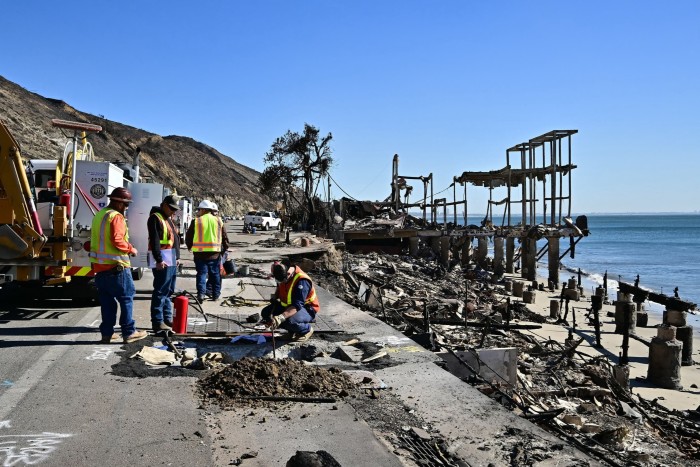After firestorms ravaged Los Angeles in January, insurers reassured investors that they had maxed out their appetite for risk in the region and would not suffer similar losses again.
Major carriers such as AIG had already pulled back from California, citing caps on what they could charge — part of a broader trend in which, as asset prices have risen and climate change has intensified extreme weather, more insurers are hitting the limits of what they will underwrite in the riskiest areas.
The retreat of household-name insurers from big markets has fed widespread distrust of the industry. Consumers report a lack of confidence in insurers, partly because claims can take months or years to be paid out.
Paris-based insurer Descartes Underwriting is among a wave of start-ups pitching a form of insurance known as parametric, which they say is fairer, more able to take on the toughest risks and could help customers recover funds just weeks after disaster strikes.
Unlike traditional models, parametric insurance offers cover at pre-agreed amounts based on a trigger, such as a wildfire or flood, that meets a certain threshold. This allows providers to skip the time-consuming claims process and loss adjustment of traditional insurance.
More stories in this report
Descartes’ clients have ranged from an electric utility buying insurance against a heatwave that could cause its transmission lines to fail, to an Australian pulp producer seeking fire cover for its tree plantations.
The business, spun out of French insurer Axa and incubated in the European Space Agency, has raised $141mn from private funds such as such as Eurazeo and Cathay Capital since launching in 2019, according to chief executive Tanguy Touffut.
“Large insurers are maxed out. They’re already exposed to a level that’s not sustainable for their balance sheet,” Touffut says. “We can provide capacity from new pockets of capital.”
Asset managers are increasingly interested in investing in parametric insurance products, which offer risks that are attractively uncorrelated with stock market performance.
For example, parametric property insurance pays out after natural catastrophes that strike at times unrelated to macroeconomic trends.
Traditional insurers have also grown their parametric offerings. For example, Generali, the nearly 200-year-old Trieste-based insurer, recently announced a €75mn fund with Descartes.
Michele Pignoli, head of Generali’s parametrics and alternative risk unit, says the insurer had seen growing demand from clients such as wind farms, which have bought policies that pay out when the wind does not blow, and large farm associations, which have bought insurance against cold snaps. European winemakers and tomato producers, for example, have become more exposed to frost.
Descartes has used satellite imaging to map exposure to bush fire on the Australian pulp producer’s tree plantations, says Touffut. In this case the policy outlined upfront how much the company would pay out if 5 or 10 per cent of the plantation were to be damaged based on factors such as the age of the trees. “We do the claim-handling work up front,” he says. “Everything would be written in the contract. Then it’s really easy to multiply the burnt areas by the value insured.”
It might not be possible to write plenty of unforeseen risks into a contract, however. Surprise tariffs, for example, could affect how much a payout covers the actual value of losses, by raising the value of the underlying commodity.
Touffut concedes that losses for a supplier recently hit with tariffs could be higher. However, he adds, since parametric policies pay out quickly, they can “minimise the differences between the assumptions made up front, and conditions at the end”.
Since parametric products are not focused on retroactively taking stock of losses, providers in Europe and the US have argued that they can more easily offer insurance cover to developing countries and remote areas where, several say, they face higher risk of fraud by claims handlers.

The risk for buyers of the products is that when a catastrophe hits, it may not breach the threshold set in the contract. For example, when Hurricane Beryl swept through the Caribbean last year, it left hundreds of thousands of homes in Jamaica without power — but narrowly missed an air pressure threshold that would have triggered payouts.
Critics say it illustrated the shortcomings of parametric products. The Jamaican government, however, issued a statement explaining that the policy it had taken out was designed to protect Jamaica from the impact of the most intense hurricanes, and that if Beryl had been more severe, “it would have certainly triggered” a payout.
Buyers of parametric insurance also run the risk that, even when the policy does pay out, their compensation will be less than the damage they sustain.
But traditional insurance policies carry that risk too, Pignoli says, due to exclusions, deductibles and claims-handling processes that can stretch out for years. “In traditional insurance, you might have the same kind of risk [due to] the complexity that a policyholder has to understand — [for which they have to know] ‘actually, am I covered or am I not covered?’” he says.
Parametrics are still a niche product but have grown quickly, with issuance of one common type of parametric catastrophe bond growing to $1.4bn last year, up from $600mn the previous year, according to AM Best.
Touffut blames the modest market size on asset managers he says are too narrowly focused on North American risks, particularly Florida hurricanes. But within 20 years, he predicts, alternative investors will have taken on more exposure to catastrophe risks than traditional insurers.
Touffut rattles off some examples: “European windstorm in London, Paris, Brussels. Wildfire in California, flood in Quebec . . . drought in Djibouti. A dam in Nepal.”
Given that natural catastrophe risk is almost entirely uncorrelated with broader financial market performance, he says, the diversified returns are too good to pass up.
https://www.ft.com/content/d480bf32-4819-4286-9f88-ad917651f155


